
by Mark Smiley | Apr 27, 2018 | General Featured
by Glen Richardson

Veteran Newsman: Award-winning broadcaster Steffan Tubbs joined the lineup on Newstalk 710 KNUS radio this year.
Popular radio newsman Steffan Tubbs who anchored 850 KOA’s Colorado Morning Show for over a decade has joined 710 KNUS after the most challenging period of his life. Tubbs texted a highly confrontational girlfriend while intoxicated. She had previously been arrested for harassing him. She turned over the text messages to the Denver Police and he was arrested on July 30, 2017. He was charged with “domestic violence” by telephone with the legal authorities declaring that he used “vulgar language with the intent to annoy the victim.” He spent 36 hours behind bars until finally being brought before a judge.
His arrest photo led the evening news on FOX 31 News and he watched his life fall apart. He was suspended by KOA Radio and he saw friends and business acquaintances disappear. He credited his legal counsel with standing up for him when almost nobody other than his family, particularly his children, were willing to do so. All charges were dropped by the Denver District Attorney in October 2017. Notwithstanding the dismissal, KOA refused to rehire him and he found no one willing to give him an opportunity.
That was until 710 KNUS morning host Peter Boyles had him fill in for him and went to bat for him at the station. When Dan Caplis the evening drivetime host at the station retired to spend more time with his family and his highly successful law practice, Tubbs applied for the job.
He is now: “A longtime newsman, now with an opinion….” That’s the introduction you hear on Newstalk 710 KNUS radio at 4 p.m. every Monday through Friday as the veteran broadcaster begins his program. The “Steffan Tubbs Show” is on weekdays from 4 to 7 p.m.
“I thought I’d had dream jobs before,” Tubbs says. “But I’m absolutely loving my new position at 710 KNUS. I’m truly blessed. After 30 years as a newsman, I’m in a learning phase of how to incorporate news with talk. I value the opinions of o

Advocate For Veterans: Steffan Tubbs is a strong advocate for veterans. He was an embedded journalist with American troops in Iraq on several occasions. Here, he is pictured with U.S. Army WWII veteran Bill Brunger.
thers and even if we disagree I think we can have productive dialogue in a civil way.”
Tubbs has 30 years of news experience. He spent more than six years as a national correspondent with ABC News based in Los Angeles, and then moved to the other coast where he worked as a reporter and anchor for FOX5-TV in New York City. Tubbs says he returned to Denver in 2005 and for the next 12 years hosted the morning drive news program on KOA NewsRadio.
Tubbs has covered some of the most important stories not just in Colorado, but also throughout the country and the world. “I reported on the Oklahoma City bombings and subsequent trials, Columbine and 9/11,” Tubbs says. “As well as every type of natural disaster including fires and hurricanes, floods and earthquakes, drought and tornadoes.”
Tubbs’ broadcasting experience expands into sports as well. He reported on multiple Super Bowls, World Series, NBA and Stanley Cup finals and even the 2002 Winter Olympics in Salt Lake City. His numerous awards are a testament to the quality of his work. Tubbs is a four-time winner of the Edward R. Murrow Award for national reporting, he’s received several Colorado Broadcasters Association awards and has twice been named best radio personality in Denver.
Tubbs also has a documentary film company where he says he funnels his passion for real, honest storytelling. His films focus on military men and women, who he proudly supports.
Tubbs says, “I end my show every day by reminding us the remember our troops.”

Drive Time: The Steffan Tubbs Show can be heard Monday through Friday from 4 p.m to 7 p.m. on Newstalk 710 KNUS radio.
The Steffan Tubbs Show launched in February of this year in the crucial afternoon drive time slot on Newstalk 710 KNUS. Tubbs says, “I am blessed and truly love what I’m doing in this new chapter of my career with 710 KNUS.”
His show rounds out the other top-rated programs including the Peter Boyles Show from 5 to 9 a.m. Monday through Friday and the Chuck Bonniwell and Julie Hayden Show weekdays from 1 to 4 p.m.
Newstalk 710KNUS has led the coverage of the Denver Mayor Michael Hancock scandal and Tubbs says, “I think the Hancock scandal is a perfect example of how real news can be combined with the comments and questions of our audience.”
Tubbs adds, “I know we’re not reinventing the wheel with yet another new talk show but that said — I really think we have a unique opportunity to do a news program that integrates callers and opinion.”
A proud dad of two teenage boys, Tubbs notes he is very engaged on social media and loves to tweet and use Facebook posts before, during and after the show. You can follow the show’s Twitter @TubbsShow or @SWTubbs as well as The Steffan Tubbs Show on Facebook.

by Mark Smiley | Mar 28, 2018 | General Featured
by Lisa Marlin
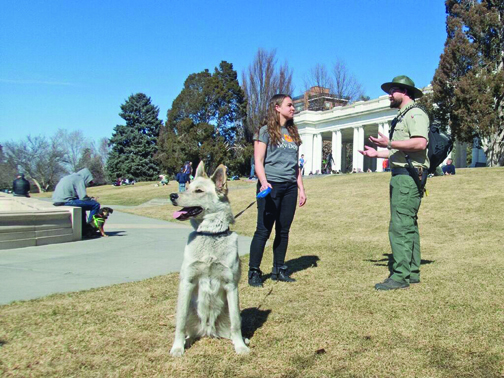
Patiently Waiting: Tugboat waits patiently on his leash while his owner Kyra Bebus visits with Sam Gannon, Denver Senior Park Ranger, at Cheesman Park. Tugboat is able to jump and play while safely on his leash, right.
“Rules are rules,” William McGihon of Denver said after he put a leash on his dog Liam when told to so by a park ranger on a warm March Sunday afternoon in Cheesman Park. “I am aware of the leash law, so I understood and was willing to cooperate obviously.”
The leash law forbids dogs to be off leash unless they are in a designated city dog park. The ordinance is posted on signs throughout the park system, but as outdoor temperatures rise, so does the number of people who ignore the ordinance, especially in Cheesman Park. In 2017, 20 percent of the 240 off-leash citations in Denver’s 228 parks were issued here.
“Cheesman Park has the highest number of off-leash dog issues, followed by Wash Park and City Park, probably because of its really big meadows and location,” said Denver Park Ranger Supervisor Jacob Wells. He also emphasized that leashes can’t be longer than six feet, so those retractable ones that allow owners to adjust the length beyond that are not okay.
It’s not just the parks that fall under the leash law. It goes for every public space throughout Denver’s jurisdiction that is not designated as a dog park. Last year, 576 off leash citations were issued outside of the park system, such as on neighborhood streets and sidewalks.
The citations carry a $100 fine for a first offense but that’s usually not the first course of action taken by animal control officers or park rangers. “We try to be more education-oriented than happy-handed,” Wells said, explaining that warnings are more frequently given and are dependent on the scenario. Someone playing frisbee with their dog when no one else is around might get a warning, but when the park is busy, the consequences are different. “A couple of years ago I came across a situation where someone was throwing a ball and their dog tripped someone else and broke their wrist,” said Wells.
Often when dog owners are confronted, they res

Leash Law: Denver Senior Park Ranger Sam Gannon reminds William McGihon that his dog Liam needs to be on a leash at Cheesman Park.
pond much like Liam’s owner did. “I just felt like he was under our supervision and control by voice command, so I thought that was probably an acceptable scenario,” McGihon said. Of course, he quickly learned it wasn’t when Sam Gannon, the senior park ranger patrolling Cheesman, stopped to chat with him.
“When I see violations, I tend to talk to people and remind them this is a park rule and we need you to follow it,” said Gannon. “And then we give them a reason, which is usually other people’s enjoyment of the park and safety. Once people get the reason behind the rule, we tend to get a lot more compliance.”
He explained that citations are used as a last resort to gain compliance with people who don’t heed a warning and decide they want to do it anyway, even with the $100 fine. A second offense jumps to a $250 fine and goes to $500 for a third.
With a citation avoided and Liam leashed, Gannon headed over to where 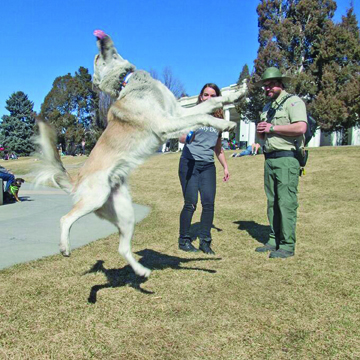 he saw a medium-sized dog running freely about 50 yards away. But since Gannon is easy to spot in his distinctive wide-brimmed hat, gray shirt and green trousers, the dog was quickly leashed by its owner before he reached them. “When people see me and they visually comply, oftentimes I will not remind them of the rule. But a lot of times if they’re visually complying they know the rule anyway,” Gannon said.
he saw a medium-sized dog running freely about 50 yards away. But since Gannon is easy to spot in his distinctive wide-brimmed hat, gray shirt and green trousers, the dog was quickly leashed by its owner before he reached them. “When people see me and they visually comply, oftentimes I will not remind them of the rule. But a lot of times if they’re visually complying they know the rule anyway,” Gannon said.
This ended up being the case with the woman who leashed her dog before Gannon got there. Later, she shared that she is from north Boulder where leash laws are different. “I don’t know Denver’s leash laws though I assume there are some,” said Lindsey Riley who was at Cheesman with her dog Clyde as he strained on his leash to play with Tugboat who was there with his owner Kyra Bebus.
As the dogs sniffed, pawed and frolicked around each other, Bebus kept a close eye and tight hold on her pet. “I know Tugboat is harmless, but he is a one-year-old puppy that weighs 80 pounds and he can get a little excited playing and that can definitely be intimidating to people who aren’t used to that,” she said. That’s why she usually heads to dog parks in the Denver-area where Tugboat can run and jump with other dogs off leash to his heart’s content. Leaving Cheesman, she took Tugboat a short distance away to the recently opened Carla Madison Dog Park off Colfax.
Wells said this newest dog park should help alleviate some of the off-leash issues. Having more rangers patrolling should also have an impact. “We bring in most of our resources when we see more people using the parks, from about April to September, he said. “Our ranger group is growing and so with more of them in the field to spot issues, the situations go down.”
They may go down, but not away. As Gannon stood just beyond where he parked his patrol unit near the Pavilion at Cheesman Park, he browsed the surrounding lawns where people and their pets were coming and going. “There will be dogs off leash here all day,” he said. Some he’ll see as he patrols and others he’ll hear about from calls made to 3-1-1, Denver’s Help Center. He’ll talk to as many dog owners as he can and hopefully see them comply, but if a citation is what it takes, he’s ready to do that too. “It is truly an issue and we do take it seriously,” he said.

by Mark Smiley | Mar 1, 2018 | General Featured
by Ed Mate, Executive Director
Colorado Golf Association
For most golf fans the return of Tiger Woods is a long overdue and welcoming sight. It is well documented that Tiger’s influence on Nielsen ratings is as direct and powerful as low interest rates on the stock market. What amazes me are those who believe that the sport either a) doesn’t really need him or even, b) is better off without him. For those it goes something like, “We have all of the young guns, like Rory, Rickie, Jordan and Dustin.” Pardon me, but that sounds more like roll call at an after school daycare than the lineup of a world class sports franchise like the PGA Tour. Let’s be honest folks, the PGA Tour needs Tiger — no, not to survive, but if the sport hopes to enjoy anything remotely close to its previous notoriety, cache and basic “cool factor” it is going to need more than Chez Reavie and Ryan “I’m no Arnold” Palmer slugging it out on the back-nine on Sunday.
Personally, the reason I am excited about Tiger’s return is only partly due to his amazing talent and golf charisma. Yes, I will enjoy watching him attempt to regain his previous form, but I am more interested in seeing how he can use his “rebirth” (if indeed that is what we are witnessing) to influence a sport that has evolved significantly since his last major championship win in 2008. Over the past 10 years the game has rolled out more innovative and forward-thinking growth of the game initiatives than it did in the previous 100 years. Drive-Chip-Putt, PGA Junior League, LPGA/ USGA Girls Golf, and Youth on Course are four of the keystone programs that have been embraced by the golf community on the local, state and national level. These programs are all designed, in different ways, to attract a wider and more diverse audience to the sport. Time will tell if they will be successful, but early evidence is extremely encouraging.
What does all this have to do with the Colorado Golf Association, or for that matter, what does it have to do with the Denver and Cherry Creek corridor who receives this publication? Quite a lot actually. The Colorado Golf Association just so happens to own and operate CommonGround Golf Course, the former Lowry Air Force Base course that went through a complete metamorphosis in 2008 — the same year Tiger took down Rocco Mediate in an 18-hole playoff to win the U.S. Open — the last of his 14 major golf championships. CommonGround, as its name suggests, was designed to be “a place for all and all the game teaches.” CommonGround is the Colorado Golf Association’s vehicle to introduce golf to those who previously had no access to the game.
The CommonGround campus includes an 18-hole championship golf course designed by world-renowned architect, Tom Doak. But it also includes a practice facility that is regarded as one of the best in the state, a nine-hole Junior Par 3 course that is absolutely free to kids under the age of 18 and an expansive community putting green that is free to everyone with a putter and some time on their hands. But more important than the campus itself, it is the programs that are hosted at CommonGround that make it such a community asset. Among these programs is the Solich Caddie & Leadership Academy that was featured in this publication last year — a program that introduces 30 to 35 young adults (mostly 8th and 9th graders) to a summer job, leadership training, and community service. The CGA uses CommonGround to create partnerships with organizations such as Big Brothers-Big Sisters, Special Olympics and a dozen neighborhood schools to bring the game to those who would never otherwise experience it. CommonGround hosts over 200 outside groups every year who make use of the facility to raise money for charity, provide after work recreation to their employees, or simply provide a gathering place for old friends.
CommonGround most certainly is living up to its name, but I can’t help but wonder how much more we could do with a champion like Tiger Woods serving an ambassadorial role. The community surrounding CommonGround is one of the most diverse of its size anywhere in the country. When you drive the Havana corridor you will see every ethnic restaurant you can imagine. Wouldn’t it be cool if Tiger used his notoriety and global brand to encourage those living in this community to identify more strongly with the sport of golf? Tiger has described himself as a “Cablinasian” speaking to his Caucasian, Black American, American Indian and Asian heritage. What could be more perfect to promote CommonGround and all it represents than Tiger Woods’ return to the world stage of golf?
With Tiger’s return it is my hope that he will do more than simply hoist trophies once again. It is my hope that instead of slamming clubs and dropping expletives, the new and improved Tiger will speak more openly about his diverse ethnic background and encourage those who look more like him to consider taking up the sport. Ultimately, Tiger Woods can do so much more than move the needle with sponsors and televisions viewers. He truly can help change the face of the game and those who play it for generations to come. In 2008 the game of golf wasn’t ready and neither was Tiger. Today the game has done its part as evidenced by what is happening right here at CommonGround.
Come on, Tiger, it’s your turn!
Tiger’s Back: Tiger Woods competed in his first back-to-back tournaments since April 2017 when he teed off at the Honda Classic on February 22, 2018, at PGA National Resort and Spa in Palm Beach Gardens, Florida.
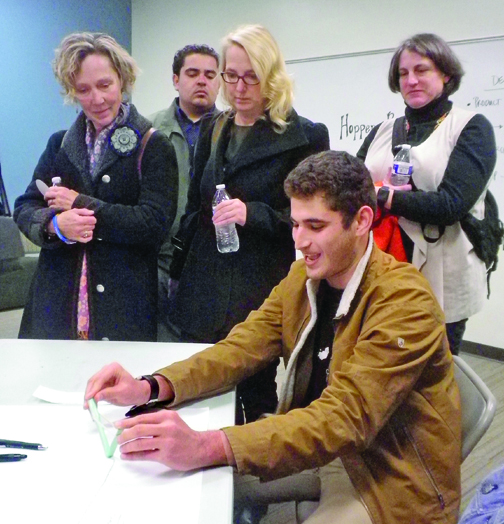
by Mark Smiley | Jan 29, 2018 | General Featured
The CUBE Focuses On Innovative Learning And Real-World Experiences
by Ruthy Wexler
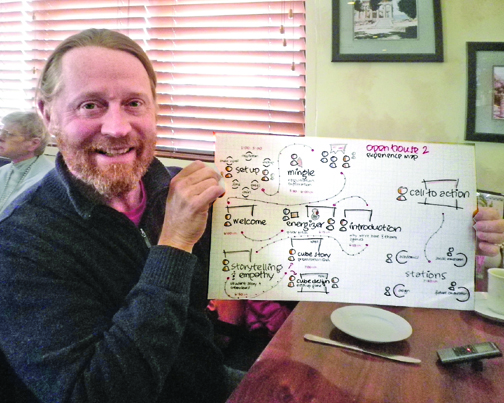
Co-Founder: Jim Stephens, co-founder of The CUBE, displays his plans for the Open House that was held on January 8, 2018. Stephens hopes to have enough students enrolled by the end of February 2018. The requirement is 93.
The CUBE, a new high school in Denver, is ready to enroll students and eager to explain how their innovative program not only boosts reading, writing, and math skills, but connects students to the real world — and their best selves.
Since Denver Public School’s school choice enrollment takes place February 1-22, The CUBE held a series of Open Houses in January, “so kids and parents could see who we are and what we do.” At the first one, held on January 8 in The CUBE’s temporary home, Vickers Boys and Girls Club, an attentive, curious group began to grasp how profoundly different this school would be.
“But don’t you have … classes?” one mother asked.
“Yes, we have classes,” smiled co-founder Bret Poppleton. “But they’re not what you’re used to. One course students can take first semester is ‘Flour, Water, Salt and Yeast.’”
“They bake bread?” said a puzzled adult.
“Yes. And that’s fun and engaging. But they also learn chemistry, math, research, writing … because all those things are involved.”
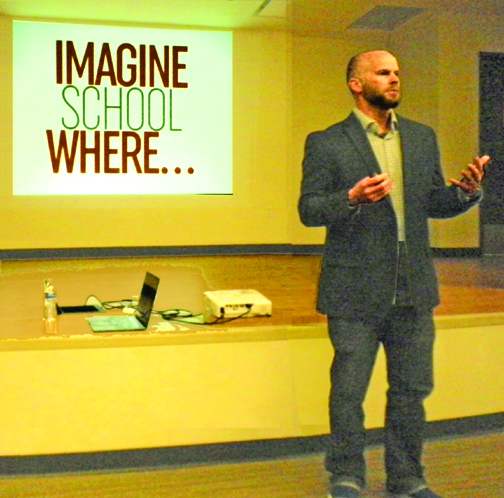
Presentation: Bret Poppleton, co-founder of The CUBE, explains CUBE concepts to parents at the Open House. School Choice for Denver Public Schools runs from February 1 to 28, 2018, and CUBE supporters hope to enroll 135 students.
Because It Was Real
“We call our courses ‘mash-ups,’” Poppleton explained. “An interdisciplinary smashing together of ideas that teaches students to think more deeply about the world. It’s actually how real learning happens. Not linear but from all directions. Starts with being engaged.”
He shared an epiphany. “In middle school, I was always complaining, ‘Why do I have to learn this?’ Then, between 10th and 11th grade, I spent a week in construction, building homes. I learned more that week, it seemed, than in a whole year of school. Because it was real.”
The CUBE’s other founder, Jim Stephens, told much the same story. “Between my sophomore and junior years of college, I went to Jamaica, a summer field school for anthropology. At first, I thought, great, a vacation. But doing excavations right there on sugar plantations with descendants of enslaved people, I understood history so deeply. I drew the artifacts, made maps. It all connected. For the first time in my life, learning came alive.”
Based On Research
What happened in Jamaica — what will occur at The CUBE — is “integrated learning,” said Stephens, who honed his educational skills for years before embarking on a “national search for the kind of place I wanted to teach” — and landed at the Denver School of Science and Technology (DSST).
“I learned so much there,” recalled Stephens, whose passionate interest in the swiftly-shifting future was shared by DSST colleague Bret Poppleton.
The more the two learned how the world was changing — how radically different the work force will soon appear — the more they wanted to equip students with the skills to “pivot”; i.e., change direction with confidence.
Soon they agreed: “Let’s open up our own school.”
“First, we needed to understand the teenage brain the same way that Montessori understands the early years,” Stephens recalled. “Studies show, for example, that the brain’s sleep pattern changes markedly during adolescence. That’s why teens fall asleep in early classes. Our classes won’t start until 9 a.m.” [Although The CUBE will stay open from 7 a.m. to 7 p.m.]
Questions
On January 8, impressed parents nonetheless had worries.
“What about standardized testing?”
“Yes, we take them. All our kids will learn to read, write, compute and think, skills absorbed so much more easily when engaged,” said Poppleton.
“Is there homework?”

Demonstration: Abcim Molavi, former student of The CUBE’s co-founders, demonstrated his solution to the Hopper Project as parents look on at the Open House held in January. The Hopper Project is statistical machine learning for advanced search of mathematical and scientific literature.
“Working on a project, doing research, that’s homework,” Poppleton said. “But they’ll love what they’re doing and learn more.”
“What about transcripts?”
“We have a transcript format that includes the traditional information, as well as social-emotional and 21st century skills data.”
“Accountability?”
“We offer fun and engagement, so we expect more participation. But we have expectations too. When students finish one of the mash-up classes, they must do three things: write a paper, create a product, do a presentation.”
Future
Earlier, Jonathan Best, The CUBE’s “Computation Jedi,” had led students to an adjoining room. After an hour, parents joined the kids, who’d been divided into groups and instructed to build “something that moved” from a box of ordinary objects.
“We’re telling them, ‘You’re smart, you can figure out how to build something that moves from these few materials,’” explained Best. “It’s not about competing. It’s building confidence to think outside the box.”
The CUBE’s founders excitedly envision a student body “where every kid knows how to code,” week-long courses “that take place in the real world, like an ice-climb in Ouray,” unlocking “the huge potential inside each child.”
Currently, they’re addressing the challenges of any new school.
“Fundraising. Finding the facility. Getting kids,” listed Poppleton. “We’ve already raised $2.5 million.”
“We’re going to take 135 students,” said Stephens. “Or more. But by the end of February, we have to have 93.”
What if too few sign up?
He smiled gently. “Well… then people aren’t ready for our school.
“But I hope they are. We’re ready for them! We can’t wait to show how powerful storytelling and empathy and mash-up classes are.
“We don’t use the term ‘alternative’ — because we believe all schools should look like this. And will, in the future.
“It’s just that The CUBE is doing it now.”
For more information, go to www.thecubeschool.org.

by Mark Smiley | Dec 17, 2017 | General Featured
Piano Playtime For Preschool Children Hits All The Right Notes With Valley Parents
by Glen Richardson

Child’s Play: Students at newly launched Gymboree Play & Music get the best possible start in overall brain development, confidence, and just plain old fun.
All right everybody gather around because the Piano Playtime kids are here. What kind of tune do you want to hear? They can play anything you want because they’re smart.
What is Piano Playtime you ask? It’s a carefully designed program for two-and-a-half to five-year-olds. Around for more than 30 years, it currently serves many private preschools in Denver’s north and west suburbs. This fall the program was formally launched at Gymboree Play & Music at I-25 and Hampden. In-home classes for groups of four or more are also offered.
Why? It gives your young one the best possible start in overall brain development, confidence, and just plain old fun! Many Piano Playtime veteran families have watched their young ones grow into amazing young musicians. They have balanced interests and varied strengths and continuous joy in learning. The program uses a rich, play-based curriculum for preschoolers. It is based on recent research in early piano learning to promote child brain development. Instruction is rooted in Gordon Research, Kodaly, Montessori, and Suzuki principles. It uses “ear before eye” for concentrated neuro-network activity. It builds higher intelligence, encourages full brain integration and full use of all sensory inputs.
Studies Support
Many recent studies in Neuroscience conclude that learning to play the piano during the preschool years is the most beneficial of any activity for building intelligence and brain function, increasing neuro-networking, concentration, coordination, confidence and brain integration. Learning piano before the age of seven grows physically larger brains. Moreover, preschool classes in violin, computers and foreign languages pale in comparison.
Piano Playtime has been carefully designed in program and curriculum to emulate language learning and literacy because music is a language, the universal language. We all learn to fluently speak our mother tongue by age six, quite miraculously without any formal study. Just being in a community with loving family, friends and loved ones gives the impetus to learn our language in a very natural and amazing way, auditory. Thus, music, specifically piano, is learned in the same way, beginning at age three when the auditory inputs are at their maximum and finger isolation begins to develop.
This is especially important for little boys. They are typically born without the ability to integrate L/R brain and are often 12-18 months behind in brain development throughout the preschool-early elementary years.

Preschool Brilliance: The piano tops computer, foreign language and violin classes in helping preschoolers function at higher levels.
Keyboard Playing Field
Many parents spend $50 or more per month for their preschoolers to play sports or other activities that have little effect on brain development or basic intellectual growth through increased brain size. Piano is the only activity that has been proven to do this. The studies are numerous and staggering in their conclusions: such as the piano tops computer, foreign language and violin classes in helping preschoolers function at higher levels and use more of their brain not only during class times but transferring to all other areas of neural function. The benefits last for a lifetime. Seems like a small price to pay for such enormous benefits.
Considering how critical the preschool years are for developing neural networks that last a lifetime, it seems shortsighted in point of view to keep preschool piano as a “luxury” rather than a staple for preschoolers.
Pre-K Standards
Piano activates, accelerates and permanently expands many neuron centers of learning. This includes speech-language, fine motor, auditory processing, visual-spatial reasoning, social-interactive, cognition, confidence and more. Playing by ear, learning beginning pre-reading skills, improvising, and creating music are all basics of the Whole Music Approach (WMA).
The program offers a well-designed curriculum based on research, natural developmental stages of children. Furthermore the curriculum is in alignment with the MENC National Standards for Pre-K. Providing fun and motivational support are key principles of the approach. WMA facilitates interactive learning and positive life skills. Parent education is a vital part of the curriculum.
The staff works with parents and caregivers to understand the vital happenings within the children’s environment that stimulate accelerated brain development, intelligence and activate nourishing relationships within the family through the children’s day to day musical learning. They make sure that parents know what is happening in the classes, encourage parent attendance and provide in-home music activities. A small class size of four to six children makes it piano intensive. Along with deeply caring parents, family, teachers and community, these benefits can only help expand the forward movement of human evolution.
Playful Package
“Play” is learning for the young child and the program takes your child’s play seriously. There is no other time in a child’s life when piano is so critical for accelerated brain growth. At Playtime classes in Denver and the Cherry Creek Valley, the Whole Music Approach (WMA) is used to develop young musicians who can play by ear, improvise freely and later compose and read music.
Youngsters are encouraged to create their own pieces, based on what they have mastered through reading music. Whatever style of piano kids and their parents would like to learn, instructors can customize lesson plans. The Whole Music Method paired with a piano is also perfect for students to create a life-long love of music. Kids are encouraged to participate in regular recitals and on-going performances and concerts.

by Mark Smiley | Nov 20, 2017 | General Featured
by Glen Richardson
 Denver Police have not implemented any recommendations from a 2016 audit meant to help officers avoid racial bias in patrol duties, a follow-up report in September 2017 finds. Denver Auditor Timothy M. O’Brien, CPA, made his original recommendations in a January 2016 audit of police operations, including updates to biased policing policies and demographic data collection.
Denver Police have not implemented any recommendations from a 2016 audit meant to help officers avoid racial bias in patrol duties, a follow-up report in September 2017 finds. Denver Auditor Timothy M. O’Brien, CPA, made his original recommendations in a January 2016 audit of police operations, including updates to biased policing policies and demographic data collection.
“It’s important for Denver Police policies to protect and serve all people equally,” explains Auditor O’Brien. “There is no way to tell if officers are stopping people without bias regarding race, gender or age if officers choose not to document demographic data.”
According to the American Civil Liberties Union (ACLU): Racial profiling refers to the practice by law enforcement officials of targeting individuals for suspicion of crime based on the individual’s race, ethnicity, religion or national origin. Criminal profiling, generally, as practiced by police, is the reliance on a group of characteristics they believe to be associated with crime. Examples of racial profiling are the use of race to determine which drivers to stop for minor traffic violations or the use of race to determine which pedestrians to search for illegal contraband.
the use of race to determine which pedestrians to search for illegal contraband.
Secret House Surveys
The previously agreed-upon recommendation involved communicating with the U.S. Department of Justice’s Office of Community Oriented Policing Services for options on how to utilize the Community Policing Self-Assessment Tool (CP-SAT). This tool could help officers evaluate the effectiveness of community policing efforts over time. Instead, Denver Police said it conducted other surveys to get input from staff. The Denver Police Foundation also conducted an independent community survey. Auditors were unable to see these survey results or the contents of the survey. Denver Police shared no information regarding the independent survey, which the Denver Police Protective Association (PPA) keeps for internal purposes.
“We cannot assess whether either survey met the spirit of or captured content similar to the CP-SAT survey,” the follow-up report says. “As a result, we consider this recommendation as having not been implemented,” the report concludes.
Other recommendations the department previously disagreed with included updating its Biased-Policing Policy to include an annual assessment of collected demographic data, and requiring officers to collect data for all pedestrian and traffic self-initiated contact. Currently, officers only collect this data for encounters that lead to a citation, arrest or street check.
Double Standard?
Within weeks following the auditor’s report, an overwhelming majority of Denver police officers say they have no confidence in the ability of Chief Robert White to lead the department. In a news conference on Oct. 24 Denver Police Protective As sn. President Nick Rogers announced than a survey of 582 union members yielded a 94 percent “no confidence” vote.
sn. President Nick Rogers announced than a survey of 582 union members yielded a 94 percent “no confidence” vote.
The vote, according to PPA, reflects a perception by the rank and file officers that there exists a lack of transparency within the police administration and a double standard applies to conduct of high-ranking members of the police administration,” Rogers told the conference.
When asked if the union had ever issued a “no confidence” vote before. Rogers replied, “Never.”
PR Policing Policy
The police department has long touted its community-oriented policing philosophy. Denver Police first incorporated community policing into its operations in the 1980s. However, without demographic data from police encounters there is no way to ensure community-policing efforts are effective or equitable. The department says it has communicated with stakeholders, including community leaders, about ways to collect more information. However, there is no plan in place at this time for collecting personal data from individuals about interactions with police.
The Department of Public Safety has not implemented any of the recommendations made in the Police Operations — District Patrol audit report. Accordingly, Auditor O’Brien has determined that the risk associated with the audit team’s initial findings has not been mitigated.
Auditor Timothy M. O’Brien, CPA, has more than 40 years of auditing and accounting experience and strives to bring greater clarity, transparency and accountability to Denver’s city government for its residents. Elected in 2015, he is distinguished from his predecessors by being an actual professional auditor. He is a licensed Certified Professional Accountant and holds the designations of Chartered Financial Analyst and Chartered Global Management Accountant.
















